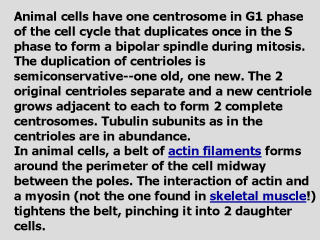| front |1 |2 |3 |4 |5 |6 |7 |8 |9 |10 |11 |12 |13 |14 |15 |16 |17 |18 |19 |20 |21 |22 |23 |24 |25 |26 |27 |28 |29 |30 |31 |review |
 |
In plant cells, a
membrane-bounded cell plate forms where the metaphase plate had been. The
cell plate, which is synthesized by the Golgi apparatus, supplies the plasma
membrane that will separate the 2 daughter cells. Synthesis of a new cell
wall between the daughter cells also occurs at the cell plate. The centrosome without membrane is a differentiated cytoplasmic area just outside the nucleus. In animals and lower plants, prophase involves the migration of 2 pairs of centrioles to opposite poles of the cell. Each pair of centrioles consists of one mature unit and a smaller newly formed centriole. Centrioles are responsible for the organization of cytoplasmic microtubules into a series of spindle fibers as an axis forms along which the chromosomal separation occurs. Although plants, fungi and certain algae lack centrioles, spindle fibers are apparent during mitosis. The spindle pole body (SPB) subsitutes for the centrosome in some lower forms. |